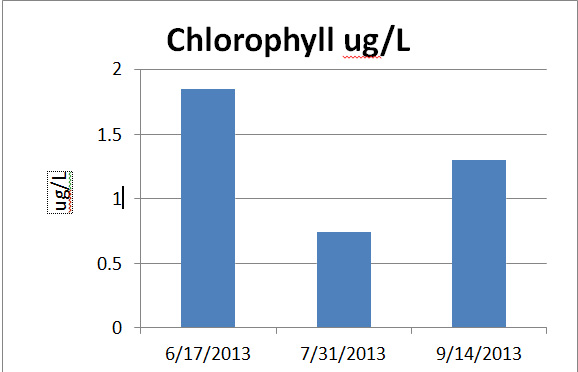Back to the LLPOA Water Monitoring Page
![]()
Back to the LLPOA Water Monitoring Page
Loon Lake Property Owners Association
Citizen Water Quality Monitoring
2013 Summary Report
Prepared by
Jim Davies April 16, 2014
This is the seventh year of the Loon Lake Property Owners' lake water quality monitoring program. Skepticism regarding the extent to which Loon Lake water quality is deteriorating has disappeared in our Water Quality Monitoring crew. Additionally, our collected data is now reinforced by the Washington State University Study presented to us in May of 2012. In the middle to late summer below 15 meters (49.2 feet) depth there is insufficient dissolved oxygen to sustain a healthy, deep/cold water Kokanee and Mackinaw fishery. Ours and the WSU data also validate studies made for the Washington Department of Fish and Wildlife that pointed to an anoxic hypolimnion (oxygen deprived deep water) limiting Loon Lake salmonid habitat (Scholz et al, 1988, McClellan et al, 2005). The causative factor is
too much nutrient (mostly phosphorus). This causes a significant increase in micro (algal) and other aquatic plant growth. When these plants die and
drift toward the bottom, they provide food for bacteria. Bacterial action results in anoxia. Bacterial remains and their wastes from the consumption of nutrients are deposited in the sediments. Sedimentary phosphorus, in the presence of anoxia is released to the waters and at autumn turnover is
distributed back to the water column restarting the cycle.
2013 Foray Dates were June 17 July 31 and September 14.
Figure 1: Summer phosphorous levels by stratum 2007 - 2013
This chart shows that after the lake becomes stratified (late May – early
June) that the amount of phosphorus at the hypolimnion (bottom) becomes greater throughout the summer peaking just before turnover (early to middle October). This is consistent with phosphorus being released from the sediments, not the inflow of nutrients from the watershed.

WATER CLARITY: The clarity of the lake's water is measured by submerging a Secchi disk until it disappears. In 1985 the Fisheries study conducted for the Department of Fish and Wildlife) by EWU reported a summer average of 6.5 meters (21 feet). Secchi disk average measurements since then are as follows: (6.1 meters = 20 feet).
1985 - 21 ft.
2007 - 20 ft.
2008 - 22.3 ft.
2009 - 22.8 ft.
2010 - 20.3 ft.
2011 - 17.4 ft.
2012 - 20.3 ft.
2013 - 21.7 ft.
Figure 2: Secchi disk clarity

Note: Measurements are also taken from top to bottom for temperature, dissolved oxygen, pH and conductivity with a Hydrolab Data Sonde. This instrument is calibrated before and after each use. It is used, stored and maintained by trained citizen volunteers.
TEMPERATURE: The temperature measured over depth for each foray is shown in Figure 3. It clearly shows typical summer stratification, a top warmer layer, the middle layer including the thermocline where the temperature drops quickly, and the cold bottom layer.
Figure 3: Temperature

DISSOLVED OXYGEN (DO): When the lake is thermally stratified the bottom layer cannot reoxygenate by mixing with the upper layer. The bacteria on the bottom, which are responsible for the decay of sediments, use up almost all the DO. Figure 4 shows that there is plenty of oxygen in the upper part of the water column but later in the summer the DO is less than four milligrams per liter (mg/L) below 15 meters. At this concentration of DO fish can survive for short periods only. Also, at these low DO levels phosphorus is released from the sediments.
Figure 4: Loon Lake Dissolved Oxygen Profile - Note: DO is shown in milligrams per liter (mg/L). A milligram is one thousandths of a gram.

NUTRIENTS: Nutrient samples are taken at the surface, half way down and at the bottom by use of a Kemmerer capture bottle. Analysis is done by the Spokane Tribal Laboratories. Elevated phosphorus (P) and Nitrogen (N) in the hypolimnion (deep waters) caused by the summer decay of organic matter can be seen in figures 5 and 6. These nutrients get remixed throughout the water column during fall turnover, fueling the next year's algal growth. Sewer District #4 was formed to stop nutrients from entering the lake. It is important that remaining sources of nutrient loading be minimized. These sources include: Storm water runoff made worse by hardscape (roofs, driveways, roads, etc.), fertilizer from landscaping and remaining septic system drain fields. Burning of waste materials over the aquifers or on the beaches leaves ash which when rained on or when mixed with runoff takes the resulting strong nutrient mix either directly to the lake or through the aquifer. It is also important to provide shoreline vegetative buffers and preserve wetlands in order to absorb nutrients as they migrate toward the lake. All new development within the Loon Lake Watershed should be regulated by the County and State in such a way so as to retain wetlands in their natural state; minimize or prevent runoff; prevent contamination of the aquifer from sewage systems through the export of effluent to a location outside the watershed (as does Sewer District #4); and protect uplands from inappropriate development so that the aquifer may continue to be recharged by precipitation.
Figures 5 and 6: Loon Lake Phosphorus and Nitrogen Levels by
Stratum


CHLOROPHYLL a:Chlorophyll a sampling is done on the surface using a Kemmerer Capture Bottle. Two 300 ml. samples are blended from 100 ml samples collected at depths of 1, 3 and 5 meters. Sample bottles are
wrapped in foil to protect them from light, are kept in cold storage until delivered (within two hours) to the Lab for analysis. Analysis results of the two samples are averaged.

Note: Detailed original data including field notes, weather and surface conditions, volunteer staff present and techniques/methods/equipment used in collecting, protecting and transporting samples, etc. are not included in this report. If you need this information please contact J. Davies at 233-2651 or the Loon Lake Property Owners Association, Water Quality Project Chair.